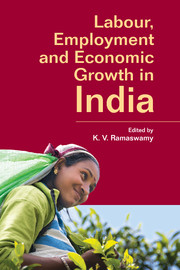Book contents
- Frontmatter
- Dedication
- Contents
- List of Tables and Figures
- Preface
- Part 1 Economic Growth and Employment
- 1 Introduction and Review of Issues
- 2 India's Labour Market during the 2000s
- 3 Services-led Growth and Employment in India
- 4 Growth, Structural Change and Poverty Reduction
- 5 Age Structure Transition, Population Ageing and Economic Growth
- 6 Labour Intensity in Indian Manufacturing
- 7 Gender Discrimination in Manufacturing Employment in India, 1999-2009
- Part 2 Employment and Labour Law
- Contributors
- Index
5 - Age Structure Transition, Population Ageing and Economic Growth
from Part 1 - Economic Growth and Employment
Published online by Cambridge University Press: 05 June 2015
- Frontmatter
- Dedication
- Contents
- List of Tables and Figures
- Preface
- Part 1 Economic Growth and Employment
- 1 Introduction and Review of Issues
- 2 India's Labour Market during the 2000s
- 3 Services-led Growth and Employment in India
- 4 Growth, Structural Change and Poverty Reduction
- 5 Age Structure Transition, Population Ageing and Economic Growth
- 6 Labour Intensity in Indian Manufacturing
- 7 Gender Discrimination in Manufacturing Employment in India, 1999-2009
- Part 2 Employment and Labour Law
- Contributors
- Index
Summary
Introduction
Age structure of a population refers to distribution of population by age, either by single year or age groups. Broadly speaking, the total population by age may be divided into young (age 0–14 years), youth (age 15–24 years), working (age 25–59 years) and elderly (age 60 years and above). Over a period of time, proportion of total population in these age groups may undergo a transition from a higher (lower) share to a lower (higher) or declining (increasing) share due to the interactive effects of fertility and mortality. This transition is called the age structure transition. For instance, a long-term decline in fertility and mortality (or longer life expectancy of life) may lead to a decline in the young and youth population and a rise in working age or elderly population. Consequently, a country with more younger and youth population today may eventually become an ageing country. Though age structure transition is a demographic phenomenon, its effects are ultimately economic in nature because population is a source of supply of labour in production and demand for goods and services in consumption and both may vary across individual years or age groups. Knowledge of age-specific aggregate production and consumption is useful to determine whether a country may be well-off or worse-off in terms of production effects and/or consumption effects of age structure transition. To quantify these macroeconomic effects of age structure transition, framework that introduces age into National Income and Product Accounts (NIPA) is needed as a basis for calculation of age profile of aggregate production and consumption and to explain and predict the long-term relationships between the age structure transition, population ageing, and economic growth. Such a framework should be useful for answering three important research questions.
(1)Does age structure transition impact national economic growth?
(2)Does population ageing retard economic growth by increasing old-age dependency ratio?
(3)Does population ageing impose a total burden on tax paying working population to financing of public support systems (e.g. universal old age pension scheme).
- Type
- Chapter
- Information
- Labour, Employment and Economic Growth in India , pp. 127 - 152Publisher: Cambridge University PressPrint publication year: 2015
- 1
- Cited by



